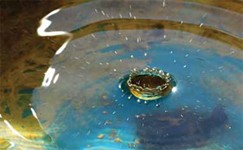Heavy Metal Banned

By Terry Sota
Researchers at Brown University have developed a new, two-step process that cleanly and efficiently removes heavy metals from water. In recently reported experiments, their cyclic electrowinning/precipitation (CEP) system removed up to 99 percent of copper, cadmium and nickel, resulting in concentrations at or below Environmental Protection Agency (EPA) standards.
The system improves upon an existing technique, electroextraction or electrotwinning, which requires a threshold concentration of metal ions to be effective. Brown engineers overcame this limitation by adding either sulfuric acid or sodium hydroxide to change the water's pH, causing the separation of the H2O molecules from the metal precipitate. The "clean" water is removed and more contaminated water is added. The steps are repeated, first redissolving the precipitate, then reprecipitating all the metal, until enough exists for successful electrowinning. This second phase involves adding an electrical current to transform positively charged metal ions into an easily separated solid state. The new method is significant not only because it is scalable and commercially viable, but also because it doesn't create toxic byproducts that endanger the environment.
Most contamination by heavy metals is the result of high-temperature combustion utilized by coal-fired power plants and solid-waste incinerators. Industrial manufacturing practices also release these pollutants, jeopardizing humans and ecosystems. Heavy metals can cause nervous system, liver and kidney damage, birth defects and even death. Although drinking water in the U.S. is carefully monitored to ensure compliance with EPA regulations, many urban estuaries are severely contaminated with heavy metals. And, in many parts of the world, food chain contamination caused by water pollutants is a real threat to human life and livelihoods.
The CEP system is a product of Brown University's Superfund Research Program (SRP) that takes a "state-based approach to environmental health research, technology development and contaminated land re-use with Rhode Island as our laboratory." The SRP is funded by the National Institute of Environmental Health Sciences, a branch of the National Institutes of Health (NIH).
Classroom Discussion
- How does pH impact trace metals in water?
- What are the distinguishing properties of heavy metals versus like elements?